ESP FIAT DOBLO 2008 1.G User Guide
[x] Cancel search | Manufacturer: FIAT, Model Year: 2008, Model line: DOBLO, Model: FIAT DOBLO 2008 1.GPages: 222, PDF Size: 3.39 MB
Page 120 of 222

119IN AN EMERGENCY
I I
N N
A A
N N
E E
M M
E E
R R
G G
E E
N N
C C
Y Y
EMERGENCY
START-UP
If the Fiat code cannot deactivate the
engine immobilising system, the warn-
ing lights ¢(Y) and Ustay on and
the engine will not start. Follow the
emergency start-up procedure to start
the engine.
Read the whole procedure carefully
before trying to carry it out. If you
make a mistake, you must turn the ig-
nition key back to STOPand repeat
the whole operation from the begin-
ning (step 1).
1)Read the 5-figure electronic code
given on the CODE card.
2)Turn the ignition key to MAR.3)Press and hold down the accel-
erator pedal. The injection system
warning light Uwill come on for
about 8 seconds, and then go out. At
this point release the accelerator ped-
al and get ready to count the flashes
of the Uinjection warning light.
4) Count the number of flashes that
corresponds to the first figure of the
code on the CODE card, then press
the accelerator pedal and keep it there
until the Uwarning light comes on
for four seconds and then goes out;
release the accelerator pedal.
5) The Uwarning light will start
flashing again: after it has flashed the
number of times that corresponds to
the second figure on the CODE card,
press the accelerator pedal to the
floor and keep it there.
6)Do the same for the remaining fig-
ures on the CODE card.7)Once the final figure has been en-
tered, keep the accelerator pedal
pressed. The Uwarning light will light
up for four seconds and then go out;
release the accelerator pedal.
8)The Uwarning light will flash
rapidly for about 4 seconds to indicate
that the operation has been complet-
ed correctly.
9) Start the engine by turning the ig-
nition key from MARto AVV.
If, however, the Uwarning light
stays on, turn the ignition key to
STOPand repeat the procedure
from step 1).
IMPORTANT After an emergency
start-up, you should contact a Fiat
Dealership otherwise you will have
to repeat the procedure described
each time you want to start the en-
gine.
119-148 Doblo GB 9-05-2008 12:09 Pagina 119
Page 122 of 222

121IN AN EMERGENCY
BUMP STARTING IF A TYRE IS
PUNCTURED
GENERAL INSTRUCTIONS
Wheel changing and correct use of
the jack and spare wheel call for some
precautions as listed below. Catalysed vehicles must
not be bump started
(pushed, towed or coast-
ed down hill) as this could cause
fuel to flow into the catalytic ex-
haust system and damage it be-
yond repair.
Remember that until
the engine has started the
brake booster and hy-
draulic power steering systems
will not work and a greater effort
will therefore be required to de-
press the brake pedal or turn the
steering wheel.
Alert other drivers that
the vehicle is stationary in
compliance with local
regulations: hazard warning
lights, warning triangle etc.
Passengers on board should
leave the vehicle, especially if it is
heavily laden. Passengers should
stay away from oncoming traffic
while the wheel is being changed.
If the wheel is being changed on
a steep or badly surfaced road,
place wedges or other suitable
material under the wheels to
stop the vehicle.
The spare wheel is vehicle-spe-
cific. Never use the wheel on oth-
er models. Never fit other mod-
el spare wheels on your vehicle.
Do not use the jack for
loads over the value indi-
cated on the plate.
The jack should only be used to
change a wheel on the vehicle for
which it was designed. It should
not be put to other uses or em-
ployed to raise other models of
vehicle. Under no circumstances
should it be used when carrying
out repairs under the vehicle.
An incorrectly positioned jack
may cause the vehicle to fall.
119-148 Doblo GB 9-05-2008 12:09 Pagina 121
Page 139 of 222

138IN AN EMERGENCY
IF A FUSE BLOWS
GENERAL
A fuse is an element for protecting
the electrical system. A fuse will trip
(i.e. it will blow) in the event of a fail-
ure or improper interventions in the
electrical system.
If an electrical device is not working,
check whether the respective fuse is
blown. The conductor A-fig. 40
should be intact. If it is not, replace the
fuse with another with the same am-
perage (same colour).
B- Undamaged fuse.
C- Fuse with broken filament.Remove the blown fuse with the
tongs provided D, which can be found
in the fusebox.
D
B
C
A
fig. 40
F0A0118b
Never replace a broken
fuse with anything other
than a new fuse. Always
use a fuse of the same colour.
Never change a fuse
with another amperage:
FIRE RISK.
Do not attempt to re-
pair a blown MAXI-FUSE.
Go to a Fiat Dealership.
Before changing a fuse,
check the ignition key has
been removed and that
all the other electric devices have
been turned off/disabled.
If the fuse blows again,
have the vehicle inspect-
ed at a Fiat Dealership.
119-148 Doblo GB 9-05-2008 12:09 Pagina 138
Page 154 of 222

153VEHICLE MAINTENANCE
IMPORTANT - Engine oil
Should prevailing use of the vehicle
be under one of the following special-
ly heavy conditions:
– towing a trailer
– on dirty roads
– for short, repeated trips (less than
7-8 km) with outside temperature be-
low zero
– frequently idling engines or long
distance low speed driving (e.g. taxis
or door-to-door deliveries) or in case
of a long term inactivity; replace en-
gine oil more frequently than required
on Service schedule
IMPORTANT - Air cleaner
If the vehicle is used on dusty roads
change the air cleaner more frequently
than the indications in the Service
schedule. If in doubt as to how often
the engine oil and air cleaner should
be changed according to how you use
the vehicle, contact a Fiat Dealer-
ship.IMPORTANT - Pollen filter
If the vehicle is used frequently in
dusty or heavily polluted environ-
ments it is advisable to replace the fil-
tering element more frequently; in
particular it should be replaced if a re-
duction of the amount of air admitted
to the passenger compartment is not-
ed.
IMPORTANT - Battery
The charge in your battery should be
checked, where possible at the start
of the winter, to limit the risk of the
battery electrolyte freezing. This check
should be carried out more frequent-
ly if the vehicle is mainly used for short
trips or if it is fitted with accessories
that permanently take in electricity
even when the ignition key is re-
moved, especially in the case of after
market accessories.You should check the battery fluid
(electrolyte) level more frequently
than shown in the service schedule in
this chapter if the vehicle is used in hot
climates or particularly demanding
conditions.
Maintenance of your ve-
hicle should be entrusted
to a Fiat Dealership. For
ordinary routine maintenance
operations which you are able to
carry out yourself, ensure that
you have the necessary tools and
original Fiat spare parts and flu-
ids available. Do not carry out
servicing operations if you have
no experience.
149-173 Doblo GB 9-05-2008 12:10 Pagina 153
Page 162 of 222
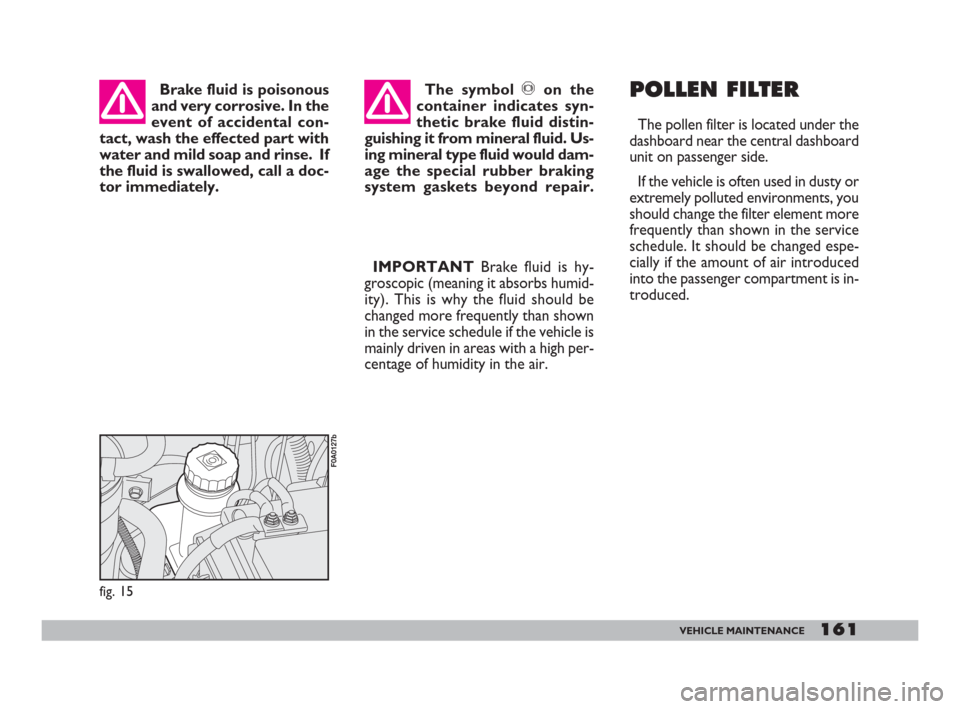
161VEHICLE MAINTENANCE
IMPORTANTBrake fluid is hy-
groscopic (meaning it absorbs humid-
ity). This is why the fluid should be
changed more frequently than shown
in the service schedule if the vehicle is
mainly driven in areas with a high per-
centage of humidity in the air.
fig. 15
F0A0127b
Brake fluid is poisonous
and very corrosive. In the
event of accidental con-
tact, wash the effected part with
water and mild soap and rinse. If
the fluid is swallowed, call a doc-
tor immediately.The symbol πon the
container indicates syn-
thetic brake fluid distin-
guishing it from mineral fluid. Us-
ing mineral type fluid would dam-
age the special rubber braking
system gaskets beyond repair.POLLEN FILTER
The pollen filter is located under the
dashboard near the central dashboard
unit on passenger side.
If the vehicle is often used in dusty or
extremely polluted environments, you
should change the filter element more
frequently than shown in the service
schedule. It should be changed espe-
cially if the amount of air introduced
into the passenger compartment is in-
troduced.
149-173 Doblo GB 9-05-2008 12:10 Pagina 161
Page 176 of 222
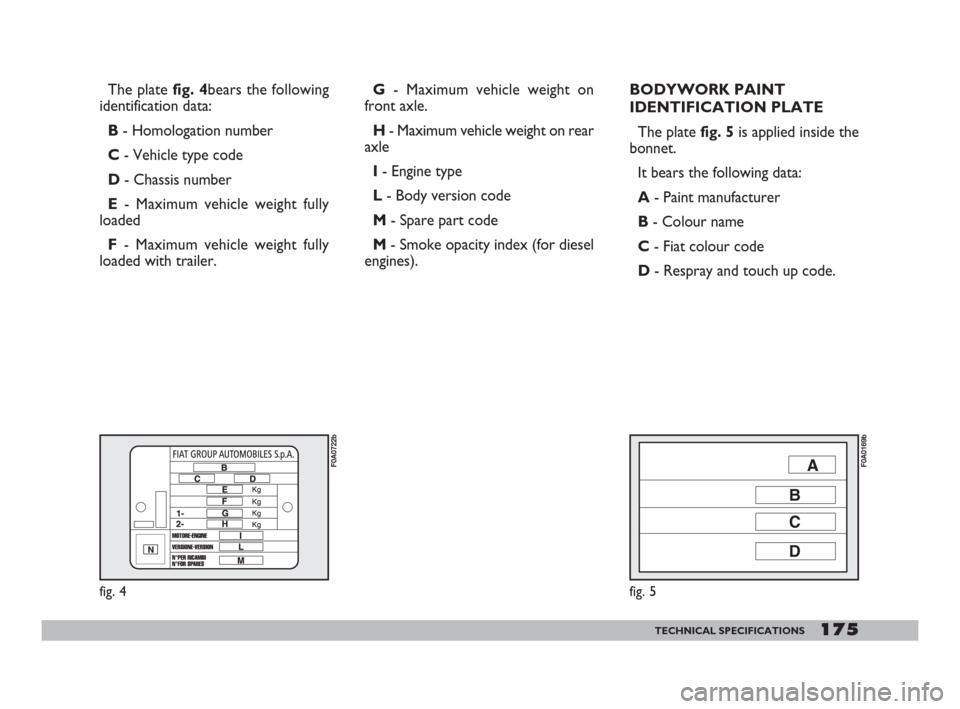
The plate fig. 4bears the following
identification data:
B - Homologation number
C - Vehicle type code
D - Chassis number
E - Maximum vehicle weight fully
loaded
F- Maximum vehicle weight fully
loaded with trailer.G- Maximum vehicle weight on
front axle.
H - Maximum vehicle weight on rear
axle
I - Engine type
L - Body version code
M - Spare part code
M - Smoke opacity index (for diesel
engines).BODYWORK PAINT
IDENTIFICATION PLATE
The plate fig. 5is applied inside the
bonnet.
It bears the following data:
A - Paint manufacturer
B - Colour name
C - Fiat colour code
D- Respray and touch up code.
fig. 4
F0A0722bA
B
C
D
fig. 5
F0A0169b
175TECHNICAL SPECIFICATIONS
174-211 Doblo GB 16-12-2008 14:26 Pagina 175
Page 180 of 222

179TECHNICAL SPECIFICATIONS
EUROPEAN HOMOLOGATION
Engine Engine code
1.9 Multijet 120 HP 186 A 9000
VersionsBodywork version code
Cargo 223ZXH1AAX
Cargo high roof223ZXH1ABX
Cargo Maxi (long wheelbase)223ZXH1AAXL
5 seater combi N1223ZXH1AAZ
Panorama 223AXH1A06
Panorama high roof223AXH1A06B
7 seater family223AXH1A06C
ENGINE
GENERAL FEATURES1.4 8v
Type code 350A1000
Cycle Otto
Number and layout of cylinders 4 in line
Piston bore and stroke mm 72,0 x 84
Total displacement cm31368
Compression ratio 11,1 : 1
Max power (CEE):
kW 57
HP 77
corresponding ratio rpm 6000
Max torque (CEE):
Nm 115
kgm 11,7
corresponding ratio giri/min 3000
Spark plugs NGK ZKR7A - 10
Fuel Unleaded
petrol
95 RON
174-211 Doblo GB 16-12-2008 14:26 Pagina 179
Page 181 of 222
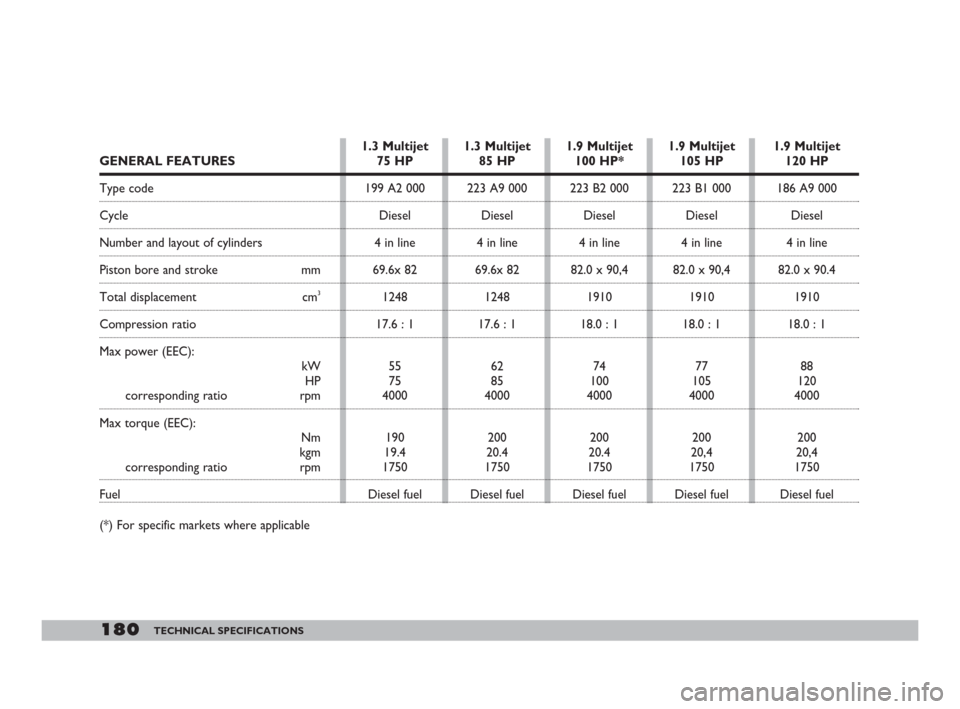
180TECHNICAL SPECIFICATIONS
1.3 Multijet
75 HP
199 A2 000
Diesel
4 in line
69.6x 82
1248
17.6 : 1
55
75
4000
190
19.4
1750
Diesel fuel 1.9 Multijet
100 HP*
223 B2 000
Diesel
4 in line
82.0 x 90,4
1910
18.0 : 1
74
100
4000
200
20.4
1750
Diesel fuel 1.9 Multijet
105 HP
223 B1 000
Diesel
4 in line
82.0 x 90,4
1910
18.0 : 1
77
105
4000
200
20,4
1750
Diesel fuel 1.9 Multijet
120 HP
186 A9 000
Diesel
4 in line
82.0 x 90.4
1910
18.0 : 1
88
120
4000
200
20,4
1750
Diesel fuel GENERAL FEATURES
Type code
Cycle
Number and layout of cylinders
Piston bore and stroke mm
Total displacement cm3
Compression ratio
Max power (EEC):
kW
HP
corresponding ratio rpm
Max torque (EEC):
Nm
kgm
corresponding ratio rpm
Fuel
(*) For specific markets where applicable1.3 Multijet
85 HP
223 A9 000
Diesel
4 in line
69.6x 82
1248
17.6 : 1
62
85
4000
200
20.4
1750
Diesel fuel
174-211 Doblo GB 16-12-2008 14:26 Pagina 180
Page 185 of 222
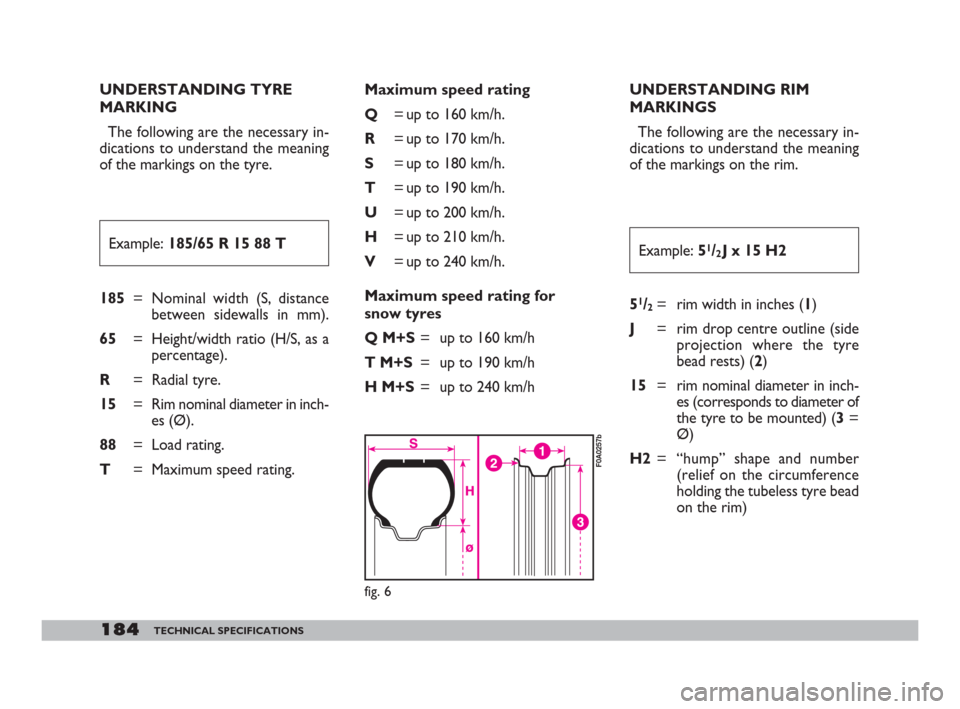
184TECHNICAL SPECIFICATIONS
UNDERSTANDING TYRE
MARKING
The following are the necessary in-
dications to understand the meaning
of the markings on the tyre.Maximum speed rating
Q= up to 160 km/h.
R= up to 170 km/h.
S= up to 180 km/h.
T= up to 190 km/h.
U= up to 200 km/h.
H= up to 210 km/h.
V= up to 240 km/h.
Maximum speed rating for
snow tyres
Q M+S= up to 160 km/h
T M+S= up to 190 km/h
H M+S= up to 240 km/hUNDERSTANDING RIM
MARKINGS
The following are the necessary in-
dications to understand the meaning
of the markings on the rim.
Example: 185/65 R 15 88 T
185= Nominal width (S, distance
between sidewalls in mm).
65= Height/width ratio (H/S, as a
percentage).
R= Radial tyre.
15= Rim nominal diameter in inch-
es (Ø).
88= Load rating.
T= Maximum speed rating.Example: 5
1/2J x 15 H2
51/2= rim width in inches (1)
J= rim drop centre outline (side
projection where the tyre
bead rests) (2)
15= rim nominal diameter in inch-
es (corresponds to diameter of
the tyre to be mounted) (3 =
Ø)
H2= “hump” shape and number
(relief on the circumference
holding the tubeless tyre bead
on the rim)
fig. 6
F0A0257b
174-211 Doblo GB 16-12-2008 14:26 Pagina 184
Page 189 of 222
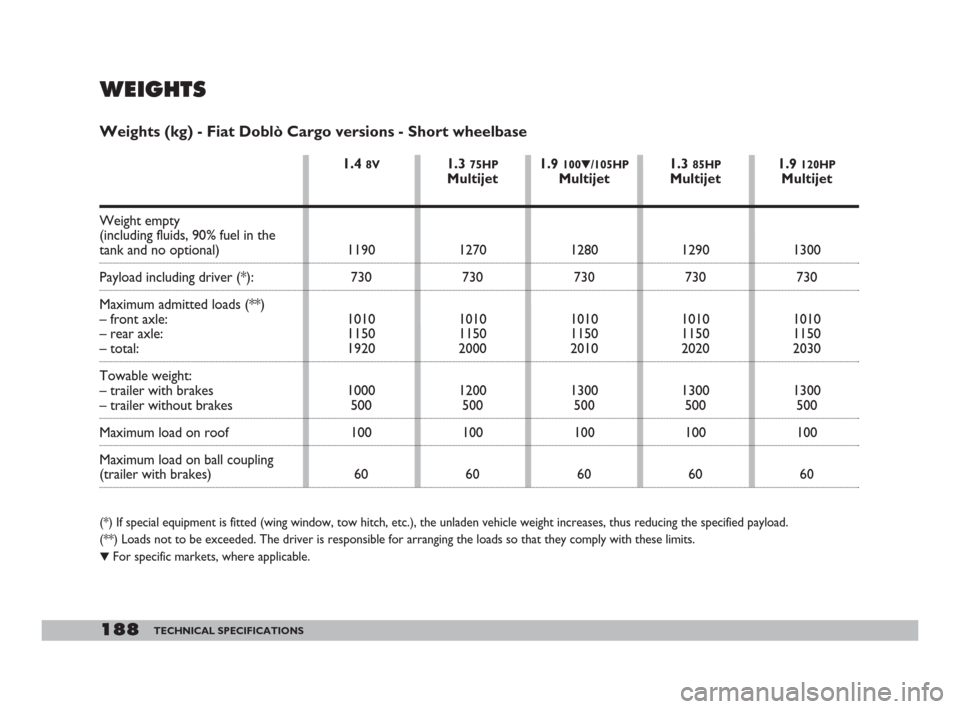
188TECHNICAL SPECIFICATIONS
WEIGHTS
Weights (kg) - Fiat Doblò Cargo versions - Short wheelbase
(*) If special equipment is fitted (wing window, tow hitch, etc.), the unladen vehicle weight increases, thus reducing the specified payload.
(**) Loads not to be exceeded. The driver is responsible for arranging the loads so that they comply with these limits.
▼For specific markets, where applicable.
1.4 8V
1190
730
1010
1150
1920
1000
500
100
601.3
75HPMultijet
1270
730
1010
1150
2000
1200
500
100
601.9 100▼/105HPMultijet
1280
730
1010
1150
2010
1300
500
100
601.3 85HPMultijet
1290
730
1010
1150
2020
1300
500
100
601.9 120HPMultijet
1300
730
1010
1150
2030
1300
500
100
60
Weight empty
(including fluids, 90% fuel in the
tank and no optional)
Payload including driver (*):
Maximum admitted loads (**)
– front axle:
– rear axle:
– total:
Towable weight:
– trailer with brakes
– trailer without brakes
Maximum load on roof
Maximum load on ball coupling
(trailer with brakes)
174-211 Doblo GB 16-12-2008 14:26 Pagina 188